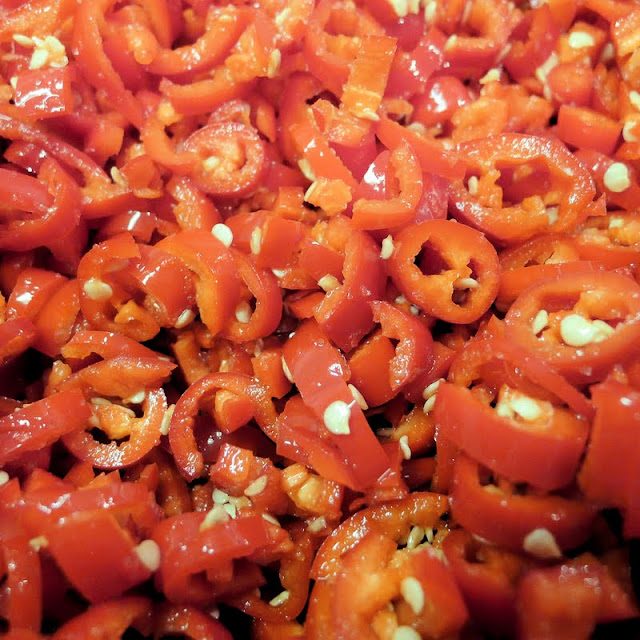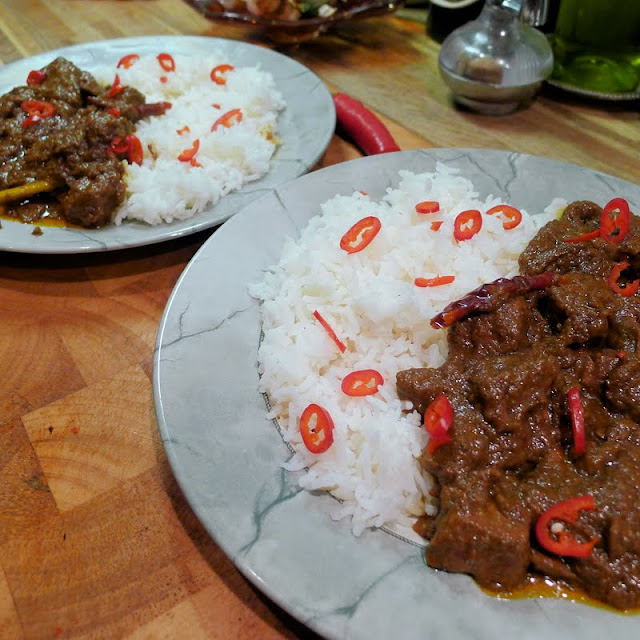Last weekend, as a thank-you for generally being lovely but for also feeding and medicating the little monsters during my recent Italy trips, I had my friends Steve & Linda over for dinner. The last time I cooked for them it was back in February for Chinese New Year. They seemed to enjoy the Sichuan dishes I served up that night so this time I thought I would give them a taste of Hunan.
Similar to Sichuan, Hunan cooking is k
nown for its liberal use of chillies. However it tends to be more "purely hot" rather than málà (hot and numbing) that distinctive taste that Sichuan cuisine is known for.
As
usual when I am cooking either Sichuan or Hunan food I turned to the excellent Fuchsia Dunlop and on this occasion The Revolutionary Chinese Cookbook.
It
should be noted that all recipes below serve four with three or four other dishes, plus rice (or two people with just one or two other dishes). There were three of us so this was more than plenty. We had: General Tso's chicken, farmhouse stir-fried pork with green peppers (which I have actually cooked before and can be found here), fisherman's prawns with Chinese chives and stir-fried broad beans with Chinese chives plus steamed rice.
General Tso's Chicken - zuo zong tang ji
This is chef Peng Chang-kuei's General Tso's Chicken, invented in Taipei, Taiwan. This version is hot and sour, more so than the Changsha (capital of Hunan) version which is closer in flavour to the sweeter Americanised dish.
4 boned, skinless chicken thighs
groundnut oil, for deep-frying
2 tsp sesame oil
For the marinade
2 tsp light soy sauce
½ tsp dark soy sauce
1 egg yolk
2 tbsp potato flour
2 tsp groundnut oil
For the sauce
1 tbsp tomato purée
½ tsp potato flour
½ tsp dark soy sauce
1½ tsp light soy sauce
1 tbsp clear rice vinegar
3 tbsp stock
8 dried red chillies
2 tsp finely chopped ginger
2 tsp finely chopped garlic
Combine all the marinade ingredients in a small bowl and set aside
Unfold the chicken thighs and lay them what would have been skin-side down, on a chopping board. If some parts are very thick slice them in half horizontally, parallel to the board.
Using a sharp knife make a few shallow criss-cross cuts into the meat to help the flavours penetrate then cut into bit sized pieces about 5cm or so in thickness
Put the chicken pieces into a bowl, pour over the marinade and toss until well coated.
In a large pan or wok, heat enough groundnut oil for deep-frying (it doesn't have to be too deep as you can easily do this in batches) to 180-200C. Add the chicken and fry until golden - remove with a slotted spoon and set aside.
Mix the tomato purée and 1 tablespoon of water in a small bowl, then add the potato flour, soy sauces, rice vinegar and set aside.
Use a pair of scissors to snip the dried chillies into 2cm pieces.
Heat a wok with 2-3 tablespoons of groundnut oil. Add the dried chillies and stir-fry briefly until they are fragrant and just changing colour (they will turn dark but don't let them burn). Add the ginger and garlic and stir-fry for a few seconds longer, until fragrant.
Pour in the combined sauce ingredients and stir until the sauce thickens. Return the chicken to the wok and stir well to coat the pieces in sauce.

Remove the wok from the heat and stir in the sesame oil. Serve with steamed rice and other dishes.
Fisherman's Prawns with Chinese Chives - yu jia chao xia qiu
500g prepared raw large prawns (you can use frozen but thaw first)
100g Chinese chives, trimmed and cut into 1¼ inch pieces
2 tsp garlic, finely chopped
1 tsp dried chilli flakes (or if you have them 1 tbsp chopped salted chillies)
1 tsp Chinkiang vinegar
1 fresh red chilli, seeded and thinly sliced
salt
1 tsp sesame oil
200ml groundnut oil for cooking
For marinade
1 tsp salt
1 tbsp potato flour
1 small egg white
Put the prawns in a bowl with the marinade ingredients, mix well and set aside.
Heat the oil in a large pan or wok over a high flame until it reaches 150C (about 300 F). Drain off excess egg white from the prawns in a colander or sieve then add them to the wok and fry briefly until pinkish but not fully cooked. Remove with a slotted spoon and set aside.
Drain off all but 3 tbsp of the oil. Add garlic and chilli flakes and stir-fry briefly until fragrant. Add the prawns, stirring well, followed by the vinegar.
Add the chives and fresh chilli and stir-fry unil they are barely cooked. Season with salt to taste, remove from the heat, stir in sesame oil and serve.
Stir-fried Broad Beans with Chinese Chives - jiu cai can dou
100g fresh Chinese chives, washed trimmed and cut into 1¼ inch lengths
200g shelled broad beans (about 800g in the pod)
2tsp finely chopped fresh red chilli (or chopped salted chillies, again if you have them)
2tsp finely chopped fresh ginger
2 tbsp groundnut oil
salt
Blanch the beans in boiling water for about 1 minute so barely cooked, drain and set aside.
Heat a wok over a high flame until smoke rises then add the oil and swirl around.
Add the chillies and ginger and stir-fry briefly until fragrant before adding the beans and stir-fry until hot & sizzling. Add salt to taste.

Throw in the chives and stir-fry a little longer until just tender and serve immediately.
And just as a reminder, here's what the farmhouse pork looks like:







































